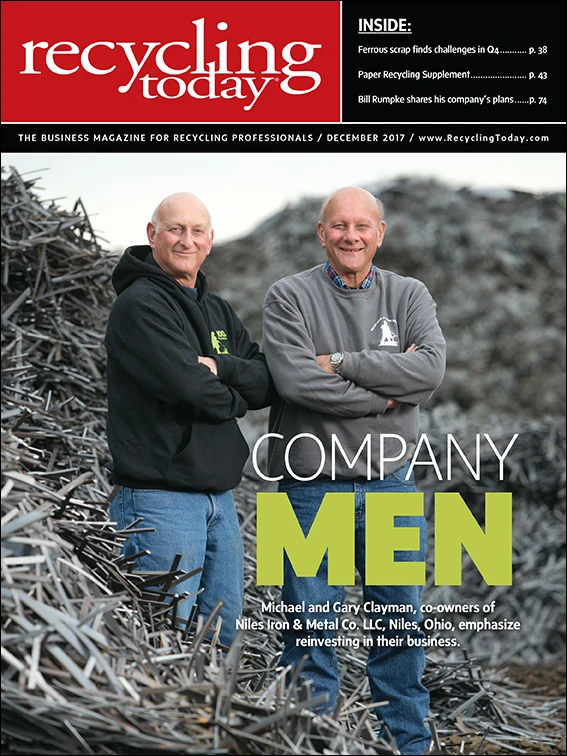Cascades invests $21M in packaging production
Cascades Inc., Kingsey Falls, Quebec, has announced a $21 million investment in its Cascades Inopak and Plastiques Cascades plants in Canada to increase production of food packaging.
The firm will invest $15 million in the Cascades Inopak plant in Drummondville, Quebec, to expand the existing building and to install a high-performance recycled polyethylene terephthalate (rPET) film manufacturing line with a built-in decontamination unit.
Cascades’ Luc Langevin says, “Cascades is the first company in North America to manufacture low-density PET packaging containing 80 percent recycled PET. Compared to the competition, we can reduce

APR seeks to expand recycled resin demand
The Washington-based Association of Plastic Recyclers (APR) has launched its Recycling Demand Champion Campaign, designed to expand market demand for recycled resins and to improve plastic recycling in North America.
The APR Recycling Demand Champion Campaign aims to increase use of polyolefin (polypropylene or polyethylene) postconsumer resin (PCR) by focusing on “work in process” (WIP) items used in manufacturing, such as trash cans, pallets
Demand Champions sign a letter of intent to identify and use these WIPs in their facilities and to require PCR content in them.
“This program will drive demand for broad specification PCR produced from mixed residential plastics,” explains Liz Bedard, director of the APR Rigid Plastic Recycling Program.
APR says it will work to expand participation in the program in partnership with brand owners, retailers, trade organizations and other members of the recycling value chain.
US PET bottle recycling rate declines in 2016
The 2016 U.S. recycling rate for polyethylene terephthalate (PET) bottles was 28.4 percent, reflecting a 2.4 percent decrease in total collection volume and an increase of more than 3 percent in the volume of PET bottles available for recycling in the U.S. This information is courtesy of the “Report on Postconsumer PET Container Recycling Activity in 2016,” which was released by the National Association for PET Container Resources (NAPCOR), Florence, Kentucky, and the Association of Plastic Recyclers (APR), Washington.
The full report can be found on the NAPCOR and APR websites at https://napcor.com/wp-content/uploads/2017/10/NAPCOR-APR_2016RateReport_FINAL.pdf and at http://plasticsrecycling.org/images/pdf/resources/reports/2016_UNITED_STATES_
NATIONAL_POSTCONSUMER_PLASTIC_BOTTLE_RECYCLING_REPORT_FINAL_VERSION.pdf, respectively.
“This was a strong year for PET bottle market growth, but another difficult one for the PET recycling industry,” says Tom Busard, NAPCOR chairman, chief procurement officer for Plastipak Packaging Inc. and president of Clean Tech, Plastipak’s recycling affiliate. “The challenges we saw in 2015—low virgin resin pricing and uncertain demand in both recycled scrap and rPET (recycled PET) end markets—continued to impact the industry in 2016. Despite these obstacles, the volume of PET collected in the United States and utilized by domestic reclaimers stayed consistent with that of 2015, and rPET used in domestic end market applications was up.”
The report’s recycling rate is derived by using the total volume of rPET material purchased by U.S. processors (reclaimers) and export markets in 2016—1,753 million pounds—taken as a percentage of the total volume of PET resin used in U.S. bottles and potentially available for recycling—6,172 million pounds. Of that 1,753 million pounds collected, 1,374 million pounds were purchased and processed by domestic PET reclaimers, with the balance of collected material, 379 million pounds, sold to export markets, including Canada. This was the lowest export volume reported since 2004, comprising 22 percent of the total postconsumer PET volumes collected, the report notes. Exports to Asia and other markets outside North America dropped 11 percent over 2015, marking the sixth year of offshore export decline.

“The PET recycling industry has taken some knocks this year, yet continues to demonstrate its strength in terms of consistent domestic material purchases and robust use of rPET in end-market sectors,” says Steve Alexander, APR president. “This is an established, vibrant and resilient industry, but its significant challenges make it increasingly incumbent upon the broader value chain—from collection to end-market users—to address key issues, including increasing the quantity and quality of
Total volumes of rPET used in American and Canadian end-market applications increased by more than 5 percent to 1,501 million pounds in 2016. Fiber, bottle and strapping markets all showed growth for the year, while rPET use in
Information for the report was obtained through surveys conducted by NewGen Strategies & Solutions, Richardson, Texas, and by More Recycling, Sonoma, California, as well as from data generated internally by NAPCOR. Support also was provided by Resource Recycling Systems (RRS), Ann Arbor, Michigan.

Explore the December 2017 Issue
Check out more from this issue and find your next story to read.
Latest from Recycling Today
- Athens Services terminates contract with San Marino, California
- Partners develop specialty response vehicles for LIB fires
- Sonoco cites OCC shortage for price hike in Europe
- British Steel mill’s future up in the air
- Tomra applies GAINnext AI technology to upgrade wrought aluminum scrap
- Redwood Materials partners with Isuzu Commercial Truck
- The push for more supply
- ReMA PSI Chapter adds 7 members







